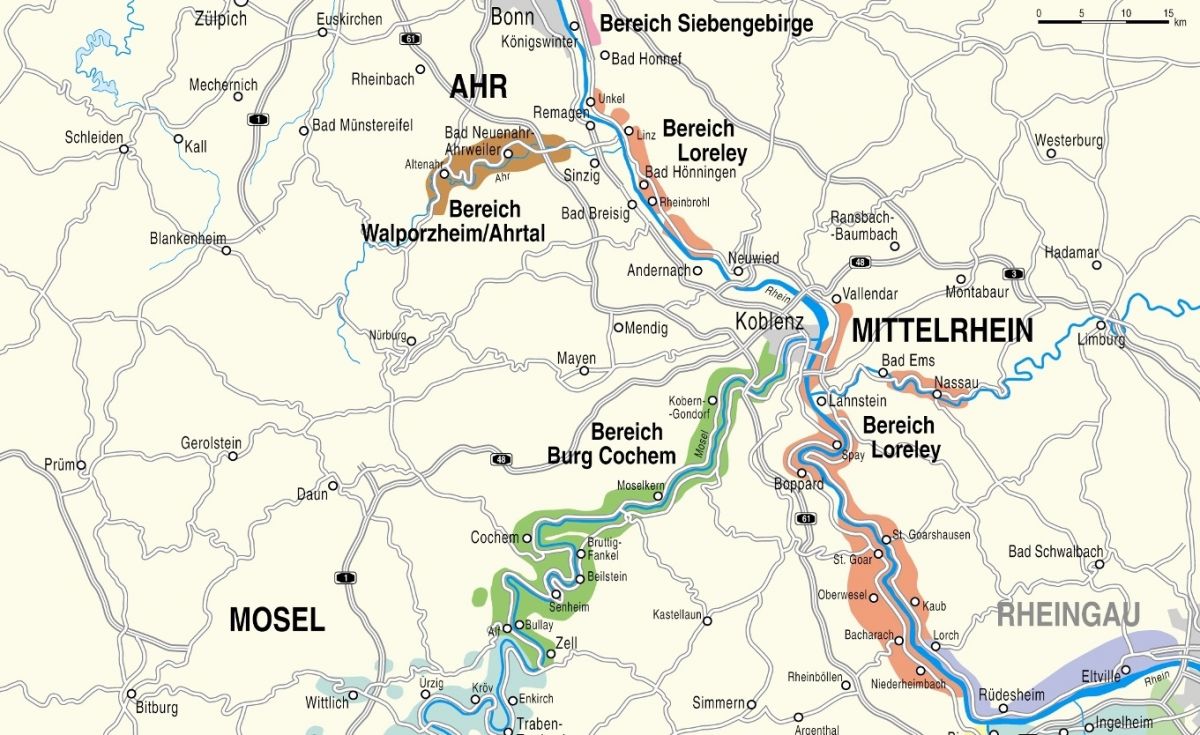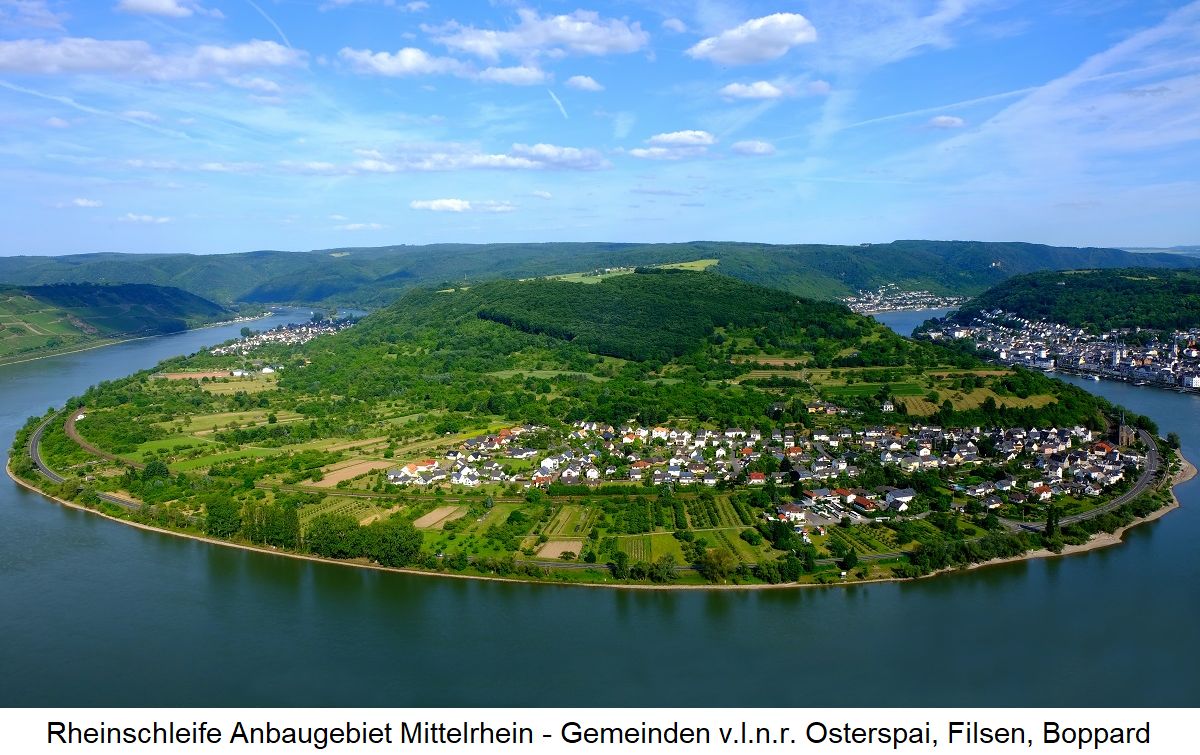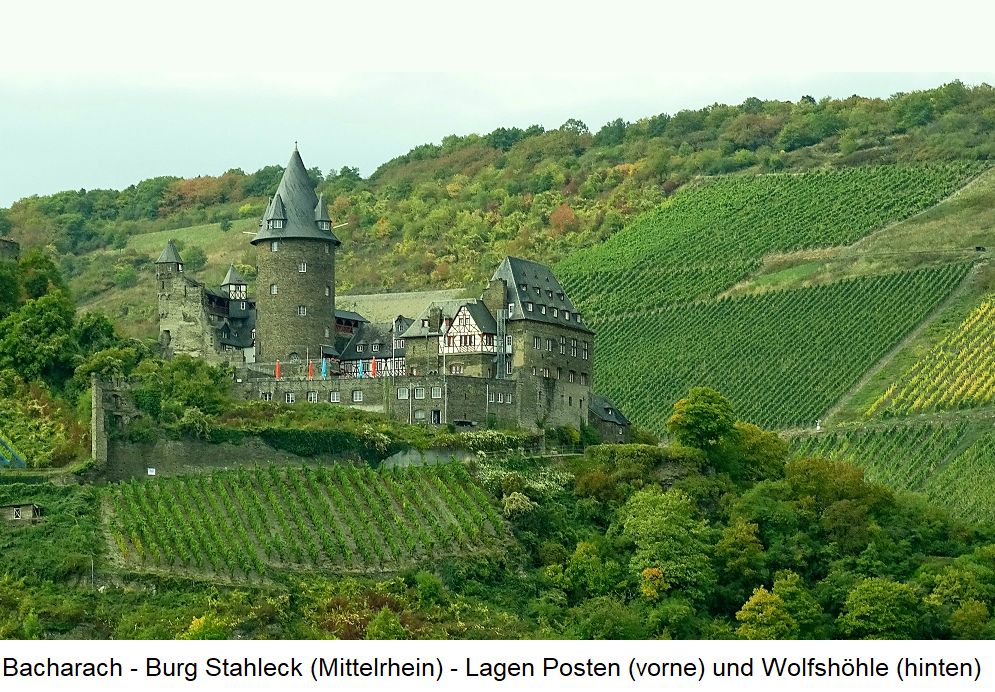Results
2,284 Results
Loading more Results ...
Loading more Results ...
| Mittelrhein |
Description to Mittelrhein
The wine-growing area is largely located in the state of Rhineland-Palatinate in Germany, with a small area in North Rhine-Westphalia. The vineyards cover 470 hectares of vines, stretching from the municipality of Oberdollendorf near Königswinter, opposite Bonn, to north of Bingen, partly on both banks of the namesake middle course of the Rhine. The city of Koblenz lies at the heart of this beautiful river landscape. Winegrowing was established here by the Romans after the founding of the cities of Cologne (Colonia) and Bonn (Bonna). It flourished in the Middle Ages under the leadership of the Cistercians, who built the Heisterbach Monastery above Oberdollendorf, which is now only in ruins. The town of Bacharach is an ancient wine trading centre.

Niederlahnstein is home to the famous "Wirtshaus an der Lahn". Near the municipality of St. Goarshausen is the world-famous 132-metre-high Loreley Rock. According to 19th-century legend, a mermaid attracted Rhine boatmen here with her lovely song and caused their boats to crash on the slate rock. The poet Heinrich Heine (1797-1856) made the Loreley world-famous with the lines "I don't know what it means that I am so sad". She is also the patron saint and emblem of the wine-growing region. Every year on the first weekend in September, the "Middle Rhine Wine Forum" is held at Rheinfels Castle, municipality of St. Goar on the Loreley Rock, and on the first Saturday in May the "Middle Rhine Wine Fair" is held in Bacharach-Steeg.
Climate and soil
The vineyards extend for over 120 kilometres on both sides of the Rhine deep into the side valleys. Some of them can also be found on the banks of the Lahn. The scenically overwhelming beauty of the area, with its many castle ruins, is presented as a narrow band of vineyards, some of which are terraced on the steeply rising slopes of the river. UNESCO also took this into account by declaring the Middle Rhine Valley between Bingen-Büdesheim and Koblenz a World Heritage Site in 2002. The wind-protected sites benefit from many sunny days; the Rhine acts as an excellent heat reservoir. The soils consist of weathered slate and greywacke, isolated islands of loess and, in the north, volcanic rock. More than 80% of the vineyards are steep slopes with at least 30% inclination, the rest are almost exclusively slopes. Some, such as the Bopparder Hamm, are among the steepest vineyards in Germany. The elaborate cultivation means that the areas are continually shrinking. In the last 30 years this has been around 40%.

Areas, communities and sites
The wine-growing region is divided into two areas, Loreley and Siebengebirge, with eleven large vineyards and 111 individual vineyards. The Loreley area is divided into ten large vineyards: Burg Hammerstein, Burg Rheinfels, Gedeonseck, Lahntal, Loreleyfelsen, Marksburg, Schloss Herrenberg, Schloss Schönburg, Schloss Stahleck and Schloss Reichenstein. Terrace viticulture is typical here. Well-known wine-growing communities with their individual vineyards are:
- Bacharach: Hahn, Heylesen Werth Island, Fürstental Monastery, Posten, Wolfshöhle
- Bad Hönningen: Schloßberg
- Bopparder Hamm: Engelstein, Fässerlay, Feuerlay, Mandelstein, Ohlenberg, Weingrube
- Braubach: Koppelstein
- Damscheid: Sonnenstock
- Dattenberg: Gertrudenberg
- Ehrenbreitstein: Kreuzberg
- Engehöll: Amber, Goldemund
- Filsen: Parish garden
- Hammerstein: Hell, In den Layfelsen
- Kamp-Bornhofen: Liebenstein-Sterrenberg, pilgrims' path
- Kaub: Baking oven, Blüchertal, Gutenfels Castle, Pfalzgrafenstein, Rauschelay, Roßstein
- Kestert: Liebenstein-Sterrenberg
- Koblenz: Kreuzberg, Schnorbach bridge section
- Leutesdorf: Forstberg, Gartenlay, Rosenberg
- Manubach: Langgarten, Mönchwingert, St. Oswald
- Niederheimbach: Froher Weingarten, Reifersley, Hohneck Castle
- Nochern: Brünnchen
- Oberdiebach: Bischofshub, Fürstenberg
- Oberheimberg: Römerberg, Sun, Truth
- Obernhof: Goetheberg
- Oberwesel: Oelsberg, Römerkrug, St. Martinsberg
- Osterspai: Liebeneck-Sonnenlay
- Patersberg: Teufelstein
- Perscheid: Rosental
- Rheinbrohl: Monte Jup, Römerberg
- Rhens: King Wenceslas, Sonnenlay
- Steeg: Hambusch, Lennenborn, St. Jost
- St. Goarshausen: Katz Castle, Maus Castle, Loreley-Edel
- Unkel: Berg, Sonnenberg
- Urbar: Beulsberg
- Vallendar: Königshof
- Weinähr: Giebelhöll

The Siebengebirge area with the Großlage Petersberg is located in the federal state of North Rhine-Westphalia and comprises around 25 hectares of vineyards. The wine-growing communities and individual vineyards:
- Bad Honnef: Drachenfels
- Bonn: Rheinaue
- Königswinter: Drachenfels, Goldenfüßchen, Heisterberg, Laurentiusberg, Sülzenberg
- Niederdollendorf: Goldenfüßchen, Heisterberg, Longenburgerberg
- Oberdollendorf: Laurentiusberg, Rosenhügel, Sülzenberg
- Rhöndorf: Drachenfels
Grape variety list
There were no major changes compared to 2009. Riesling is in the lead with two thirds of the stock, followed by Pinot Noir with just under 10%. The status in 2018 (0 = less than 0.5 ha):
| Grape variety dt. Main name |
In Germany common synonyms |
Colour | Hectare 2018 |
%- Ant |
Hectare 2009 |
| Riesling | White Riesling, Rhine Riesling | white | 308 | 66,2 | 306 |
| Pinot Noir including Samtrot |
Pinot Noir, Blue S., Pinot Noir Blue Pinot Noir clone Samtrot |
red | 46 | 9,9 | 40 |
| Müller-Thurgau | Rivaner, Riesling-Sylvaner | white | 23 | 5,0 | 28 |
| White Burgundy | Pinot Blanc, Pinot Blanc | white | 21 | 4,5 | 13 |
| Ruländer | Pinot Gris, Pinot Gris | white | 17 | 3,7 | 10 |
| Dornfelder | - | red | 11 | 2,4 | 14 |
| Kerner | - | white | 8 | 1,7 | 14 |
| Portugieser | Blue Portugieser | red | 5 | 1,1 | 7 |
| Scheurebe | Seedling 88 | white | 5 | 1,1 | 5 |
| Chardonnay | - | white | 3 | 0,7 | 1 |
| Regent | - | red | 3 | 0,7 | 4 |
| Red Traminer | Traminer / Gewürztraminer | white | 2 | 0,4 | 2 |
| Sauvignon Blanc | Muscat Sylvaner | white | 2 | 0,4 | 0 |
| Bacchus | - | white | 1 | 0,2 | 2 |
| Cabernet Dorsa | - | red | 1 | 0,2 | 0 |
| Dark field | - | red | 1 | 0,2 | 2 |
| Ehrenfelser | - | white | 1 | 0,2 | 1 |
| Yellow Muscat | Muscat Blanc, Muscat | white | 1 | 0,2 | - |
| Huxel grape | - | white | 1 | 0,2 | 1 |
| Müllerrebe | Black Riesling, Pinot Meunier | red | 1 | 0,2 | 1 |
| Silvaner | Green Silvaner, Sylvaner | white | 1 | 0,2 | 1 |
| Auxerrois | Small Heunisch | white | 0 | - | 0 |
| Cabernet Blanc | - | white | 0 | - | - |
| Cabernet Cortis | - | red | 0 | - | - |
| Cabernet Franc | - | red | 0 | - | - |
| Cabernet Mitos | - | red | 0 | - | - |
| Faberrebe | - | white | 0 | - | 1 |
| Frühburgunder | Blue Frühburgunder, Clevner | red | 0 | - | 0 |
| Helios | - | white | 0 | - | - |
| Dakapo | - | red | 0 | - | 0 |
| Cover red | - | red | 0 | - | 0 |
| Ehrenbreitsteiner | - | white | 0 | - | 0 |
| Gold muscatel | - | white | 0 | - | - |
| Grüner Veltliner | Weißgipfler | white | 0 | - | 0 |
| Johanniter | - | white | 0 | - | 0 |
| Merlot | - | red | 0 | - | - |
| Morio muscat | - | white | 0 | - | - |
| Muscaris | - | white | 0 | - | - |
| Optima | Optima 113 | white | 0 | - | 1 |
| Ortega | - | white | 0 | - | 1 |
| Phoenix | - | white | 0 | - | 0 |
| Reichensteiner | - | white | 0 | - | 0 |
| Rotberger | - | red | 0 | - | 0 |
| Red Elbling | Elbling, Kleinberger | white | 0 | - | 0 |
| Schönburger | - | white | 0 | - | 0 |
| Saint Laurent | Saint Laurent | red | 0 | - | 0 |
| Solaris | - | white | 0 | - | - |
| Souvignier gris | - | white | 0 | - | - |
| Syrah | Shiraz | red | 0 | - | - |
| Würzer | - | white | 0 | - | 0 |
| Bouvier | Boulder | white | - | - | 0 |
| Cabernet Sauvignon | - | red | - | - | 0 |
| Muscat Ottonel | - | white | - | - | 0 |
| Nobling | - | white | - | - | 0 |
| Osteiner | - | white | - | - | 0 |
| Précoce de Malingre | Formerly Malingre, Malinger | white | - | - | 0 |
| other white varieties | - | white | 3 | 0,7 | 0 |
| other red varieties | - | red | 0 | - | 0 |
| WHITE SORT | 400 | 85,1 | 389 | ||
| RED SORT | 70 | 14,9 | 69 | ||
| TOTAL | 470 | 100 | 458 |
Producers
Well-known producers include Bastian Friedrich, Didinger, Dr. Kauer, Heilig Grab, Hohn Peter, Königshof, Lambrich Albert, Lanius-Knab, Mohr und Söhne, Müller Matthias, Perll August, Ockenfels, Ratzenberger, Toni Jost Hahnenhof, Villa Riesling and Weingart Florian.
Classified wine producers in Mittelrhein 5
find+buy for Mittelrhein 10
Recent wines 1356
 Weingut Toni Jost - Hahnenhof
— Mittelrhein
2023 Bacharach Riesling Kabinett feinherb
10.20 €
Weingut Toni Jost - Hahnenhof
— Mittelrhein
2023 Bacharach Riesling Kabinett feinherb
10.20 €

 Weingut Toni Jost - Hahnenhof
— Mittelrhein
2021 Oberdiebach Am Schloßberg Riesling Spätlese
16.00 €
Weingut Toni Jost - Hahnenhof
— Mittelrhein
2021 Oberdiebach Am Schloßberg Riesling Spätlese
16.00 €

The most important grape varieties
More information in the magazine
- Off to the fridge! Red wines for the summer
- The best sparkling wines for the European Championships Celebrate, but do it right!
- Light wines for bright nights Tasting
- Karl Haidle Winery Collection of the year 2023/2024 - Württemberg
- AdamsWine Collection of the year 2023/2024 - Rheinhessen
- Winery Künstler Collection of the year 2023/2024 - Rheingau
- Winery Dr Bürklin-Wolf Collection of the year 2023/2024 - Palatinate
- Winery Emrich-Schönleber Collection of the year 2023/2024 - Nahe
- Van Volxem Winery Collection of the year 2023/2024 - Mosel
- Florian Reus Discovery of the year 2023/2024 - Franconia

